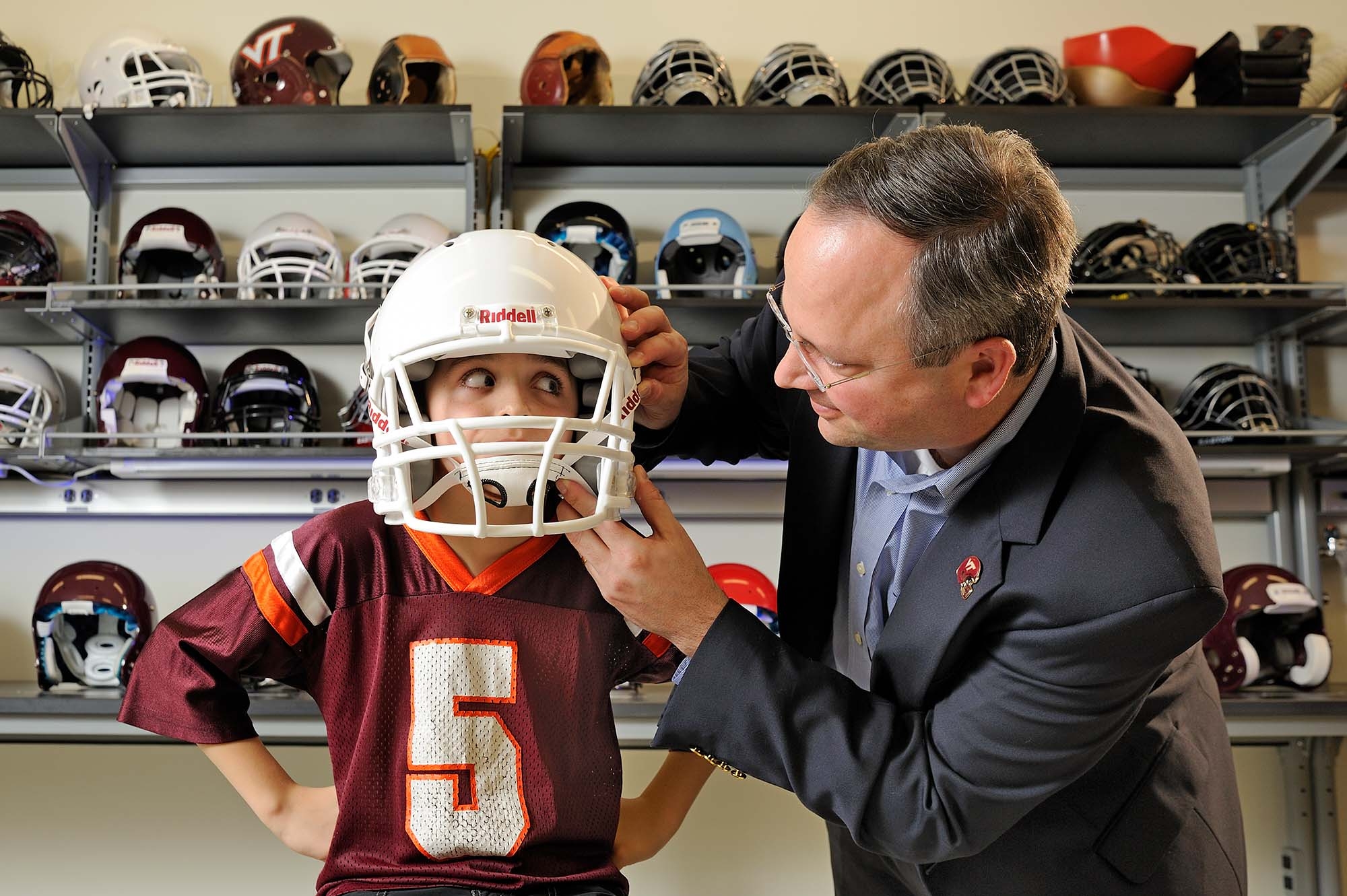
Stefan Duma has told the story of Lester Karlin’s phone call before. One day in 2009, Karlin — then the equipment manager for Virginia Tech Athletics — called him up “and asked what helmets I would recommend that he buy for the football team.”
Two years later, Duma’s lab published the first independent safety ratings for varsity football helmets. Ten years after that, what became the Virginia Tech Helmet Lab has rated protective headgear for six sports, and more are in the works. The ratings initiated a sea change in how sports equipment is designed and marketed, driving the development of better equipment by shifting the balance of information from companies to consumers.
Duma, the Harry Wyatt Professor of Engineering, had already earned national recognition for his work in injury biomechanics. But he was the one Karlin called for helmet advice that day because, since 2003, the researcher had been working with football team physician Gunnar Brolinson, associate athletics director Mike Goforth, and then-head coach Frank Beamer to study head impacts in college football using a new kind of sensor that could be embedded directly in the players’ helmets.
At a time when awareness of concussion was just surfacing as a serious problem in contact sports, these sensors gave researchers the first direct access to quantitative data about the forces players’ heads were subjected to on the field. Duma had never evaluated the helmets themselves, though, and wasn’t sure what to tell Karlin.
But he was curious. So he went out and bought every model of varsity football helmet on the market and carted them back to the basement lab, then mostly devoted to Duma’s auto safety research. Much of the floor space was occupied by a sled designed to simulate car crashes, but Duma and his team carved out space along the back wall for a drop tower that could reproduce football-style impacts with a dummy headform that plummeted like the blade of a guillotine down cables onto an anvil. Sensors hidden inside the head’s rubbery blue casing recorded the hit.
Using the thousands of impacts they’d recorded on the field, Duma and a team of graduate students — led by Steve Rowson, who now directs the lab — developed a system of impact tests at different forces and angles that reflected how players actually hit their heads. The system, which they called Summation of Tests for the Analysis of Risk — STAR — generated a numerical value that described how effectively each helmet reduced the force on the head, compared to wearing no helmet at all. The scores were plotted on a scale from zero to five stars.
“What we were doing was totally different than anything else that was available at the time,” Duma said.
Since the 1970s, all football helmets sold in the U.S. have had to clear a pass-fail standard established by the National Operating Committee for Standards on Athletic Equipment (NOCSAE) certifying they could keep forces on a player’s head below a threshold associated with catastrophic injuries like skull fractures. But those test results weren’t public, and Duma and Rowson’s data showed that that simple threshold was obscuring huge variation in performance.
“We were really surprised,” said Rowson, an associate professor of biomedical engineering and mechanics. “And we realized that no one was putting any of this information out there.”
NOCSAE’s standard also didn’t address forces below that catastrophic threshold.
Duma and Rowson’s rating system was the first to account for these concussion-level forces. When they released their results, Duma said, “It was like a light-switch change in the sport.” Colleges collectively ditched their poorly performing helmets (which were a lot of them: about half of varsity squads were playing in a popular helmet that managed only one star) and shelled out for more protective ones.
Once we started talking to parents and coaches, it was obvious that there was an extraordinary demand for this information,” Duma said. “Helmets are heavily marketed, and people are used to hearing everyone say, ‘our helmet’s the best.’ The independence and the science behind our research really resonated with people.”
The lab made a point of not accepting funding from helmet companies, and the researchers, invited all over the country to give talks on the STAR system, donated their speaking fees to buy new helmets for local youth teams.
The ratings are all available publicly, on a website that has racked up more than a million unique visitors at a rate of about 1,000 a day. The lab’s work has been covered in The New York Times, The Washington Post, Sports Illustrated, WIRED, and on hundreds of broadcast channels and ESPN. Major manufacturers use the lab’s logo as a point of pride for high-performing products, and a flag football league in Texas mandates headgear that earns at least four stars in the lab’s ratings.
Over the next few years, Duma and Rowson hope to extend the ratings to all major helmeted sports; testing is underway for baseball, softball, whitewater, and equestrian helmets. The equestrian project, part of a collaboration with the US Equestrian Foundation and the U.S. Hunter Jumper Association, has already attracted more than $425,000 in private funding.
“When we started we had no idea that helmet research would become as big as it has,” Duma said. “We just thought we would help the football team figure out which helmets were better.”
Hundreds of thousands of impacts later, it’s safe to say they did.




